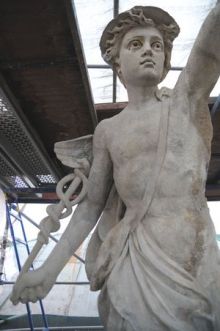Public initiative “Save Mercury” was launched in May of 2011 – then Lviv residents began raising funds for the restoration of Mercury (figure on the front of the house on Sichovykh Striltsiv Street, 3) and the sum of money needed for this, according to preliminary estimates, was more than 100,000 hryvnias. The president of the charity foundation “Preservation of Historical and Architectural Heritage of the City of Lviv” Andrii Saliuk told The Day that the sculpture was in a very bad shape: “In many spots the surface was so destructed that it practically fell into pieces if taken by a hand.”
The sculpture of the god of trade and protector of travelers was restored by specialists from Restoration Department at Lviv Polytechnic. The sculptural work was performed by Liubov Bulhakova. The restoration project was supervised by GIZ expert Dirk Bruggemann. They say that it took the longest to work on a hand. Both wings and caduceus [warder.–Author] also required a lot of work.
Lviv residents donated 43,000 hryvnias for restoration of Mercury. German Society for International Cooperation GIZ also joined in the common effort financially (they donated 160,000 hryvnians) and professionally. The cooperation took place within the project “Municipal Development and Rehabilitation of the Old City of Lviv.”
“Such public initiatives as ‘Save Mercury’ are absolutely necessary,” believes Iris Gleichmann, head of the GIZ project in Lviv. “Mercury has become a symbol of love of Lviv residents to their heritage, of their sensibility and active position.
Besides, from the professional point of view, experience of the experts from the Restoration Department at Lviv Polytechnic was important because the restorers combined traditional methods of sculpture restoration with innovative technologies in their work. Hopefully, Mercury as a symbol of rapid progress and movement will give a good start to active rescue of other treasures of stone on the facades and roofs of old stone building in Lviv.”
“Restored Mercury will now adorn the building for another couple of centuries,” added sculptor Bulhakova.
The Day’s FACT FILE
Mercury was created together with the building, which it decorates, in 1887. At that time it was the Railroad Office and the street was called May 3 – after the date of adoption of the Polish constitution. The statue crowns the attic of a Neo-Renaissance building and is the epitome of trail traffic – the fastest means of transportation at that time. The architect of the building is Wincenty Rawski Jr., graduate of Lviv and Vienna University of Technology. The author of the sculpture is professor at Lviv Polytechnic Leonardo Marconi (1835-99).







